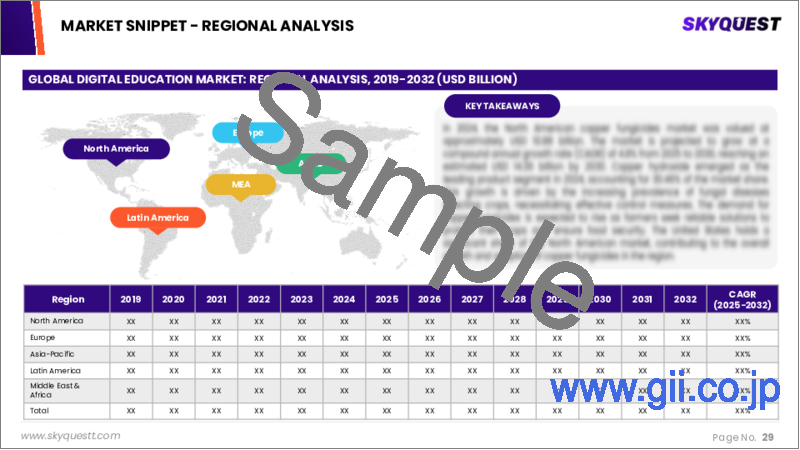|
|
市場調査レポート
商品コード
1610756
デジタル教育市場規模、シェア、成長分析、学習別、コース別、最終用途別、技術別、地域別- 産業予測、2024年~2031年Digital Education Market Size, Share, Growth Analysis, By Learning (Self-Paced, Instructor Paced), By Course, By End Use, By Technology, By Region - Industry Forecast 2024-2031 |
||||||
|
|||||||
| デジタル教育市場規模、シェア、成長分析、学習別、コース別、最終用途別、技術別、地域別- 産業予測、2024年~2031年 |
|
出版日: 2024年12月07日
発行: SkyQuest
ページ情報: 英文 175 Pages
納期: 3~5営業日
|
全表示
- 概要
- 目次
デジタル教育の世界市場規模は、2022年に172億米ドルと評価され、2023年の243億米ドルから2031年には1,910億米ドルに成長し、予測期間中(2024年~2031年)のCAGRは29.4%で成長する見通しです。
デジタル教育市場は、Technology Enhanced Learningとデジタル・ラーニングを包含し、スマートフォンの普及台数の増加とインターネットの普及率の上昇に牽引され、大きな成長を遂げています。主な構成要素には、従来の教室での学習とオンライン・リソースを組み合わせたブレンデッド・ラーニングや、バーチャル学習環境などがあります。パーソナライズされた学習、効果的な自己学習、批判的思考スキルの強化といった属性は、学生や専門家によって高く評価されています。新しい技術、特にAR(Augmented Reality:拡張現実)は、デジタル・グラフィックスやマルチメディアを実世界の設定に統合し、双方向性とエンゲージメントを促進することで、教育状況を一変させつつあります。この統合は、学習者の問題解決能力とコラボレーション能力を促進します。世界中の学校や大学でARの導入が進むにつれ、デジタル教育の可能性は拡大し続け、学習体験の近代化における役割が強調されています。
目次
イントロダクション
- 調査の目的
- 調査範囲
- 定義
調査手法
- 情報調達
- 二次データと一次データの方法
- 市場規模予測
- 市場の前提条件と制限
エグゼクティブサマリー
- 世界市場の見通し
- 供給と需要の動向分析
- セグメント別機会分析
市場力学と見通し
- 市場概要
- 市場規模
- 市場力学
- 促進要因と機会
- 抑制要因と課題
- ポーター分析と影響
- 競争企業間の敵対関係
- 代替品の脅威
- 買い手の交渉力
- 新規参入業者の脅威
- 供給企業の交渉力
主な市場の考察
- 重要成功要因
- 競合の程度
- 主な投資機会
- 市場エコシステム
- 市場の魅力指数(2023年)
- PESTEL分析
- マクロ経済指標
- バリューチェーン分析
- 価格分析
- 技術の進歩
- 規制情勢
- ケーススタディ
- 特許分析
デジタル教育市場規模:学習別& CAGR(2024年~2031年)
- 市場概要
- 自分のペース
- インストラクターのペース
デジタル教育市場規模:コース別& CAGR(2024年~2031年)
- 市場概要
- 科学技術工学数学(STEM)
- ビジネスマネジメント
デジタル教育市場規模:最終用途別& CAGR(2024年~2031年)
- 市場概要
- 学術機関
- 個人
- 企業
デジタル教育市場規模:技術別& CAGR(2024年~2031年)
- 市場概要
- モバイルEラーニング
- 学習管理システム
デジタル教育市場規模& CAGR(2024年~2031年)
- 北米(学習、コース、最終用途、技術)
- 米国
- カナダ
- 欧州(学習、コース、最終用途、技術)
- 英国
- ドイツ
- スペイン
- フランス
- イタリア
- その他欧州
- アジア太平洋(学習、コース、最終用途、技術)
- 中国
- インド
- 日本
- 韓国
- その他アジア太平洋
- ラテンアメリカ(学習、コース、最終用途、技術)
- ブラジル
- その他ラテンアメリカ
- 中東およびアフリカ(学習、コース、最終用途、技術)
- GCC諸国
- 南アフリカ
- その他中東・アフリカ
競合情報
- 上位5社の比較
- 主要企業の市場ポジショニング(2023年)
- 主な市場企業が採用した戦略
- 市場の最近の動向
- 企業の市場シェア分析(2023年)
- 主要企業の企業プロファイル
- 会社概要
- 製品ポートフォリオ分析
- セグメント別シェア分析
- 収益の前年比比較(2021年~2023年)
主要企業プロファイル
- Coursera Inc.(United States)
- edX Inc.(United States)
- Pluralsight LLC(United States)
- Brain4ce Education Solutions Pvt. Ltd.(Edureka)(India)
- Udacity, Inc.(United States)
- Udemy, Inc.(United States)
- Miriadax(United Kingdom)
- Jigsaw Academy(India)
- Iversity(Germany)
- Intellipaat(India)
- FutureLearn(United Kingdom)
- Intellipaat Edmodo(India)
- Kadenze(United States)
- Khan Academy(United States)
- LinkedIn(United States)
- Linkstreet Learning(India)
結論と推奨事項
Global Digital Education Market size was valued at USD 17.2 billion in 2022 and is poised to grow from USD 24.3 billion in 2023 to USD 191 billion by 2031, growing at a CAGR of 29.4% during the forecast period (2024-2031).
The digital education market, encompassing Technology Enhanced Learning and digital learning, is experiencing significant growth, driven by the rising adoption of smartphones and increased internet penetration. Key components include blended learning, which combines traditional classroom settings with online resources, and virtual learning environments. Attributes like personalized learning, effective self-directed learning, and enhanced critical thinking skills are highly valued by students and professionals alike. Emerging technologies, particularly Augmented Reality (AR), are transforming the educational landscape by integrating digital graphics and multimedia into real-world settings, fostering interactivity and engagement. This integration promotes problem-solving abilities and collaboration skills among learners. As schools and colleges worldwide increasingly embrace AR, the potential of digital education continues to expand, highlighting its role in modernizing learning experiences.
Top-down and bottom-up approaches were used to estimate and validate the size of the Global Digital Education market and to estimate the size of various other dependent submarkets. The research methodology used to estimate the market size includes the following details: The key players in the market were identified through secondary research, and their market shares in the respective regions were determined through primary and secondary research. This entire procedure includes the study of the annual and financial reports of the top market players and extensive interviews for key insights from industry leaders such as CEOs, VPs, directors, and marketing executives. All percentage shares split, and breakdowns were determined using secondary sources and verified through Primary sources. All possible parameters that affect the markets covered in this research study have been accounted for, viewed in extensive detail, verified through primary research, and analyzed to get the final quantitative and qualitative data.
Global Digital Education Market Segmental Analysis
Global Digital Education Market is segmented by Learning, Course, End Use, Technology and Region. Based on Learning, the market is segmented into Self-Paced, Instructor Paced. Based on Course, the market is segmented into Science, Engineering, Technology, Mathematics (STEM), Business Management. Based on End Use, the market is segmented into Academic Institutions, Individuals, Enterprises. Based on Technology, the market is segmented into Mobile E Learning, Learning Management System. Based on Region, the market is segmented into North America, Europe, Asia Pacific, Latin America and Middle East & and Africa.
Driver of the Global Digital Education Market
One of the key factors propelling the Global Digital Education market is the growing adoption of online learning solutions across educational institutions. These digital platforms enhance course management and offer interactive content along with diverse assessments tailored to meet individual learning requirements. Moreover, they provide learners with the flexibility to access educational resources from any location globally, allowing them to study at their own pace. This approach is especially beneficial for individuals with hectic lifestyles, as it accommodates their unique scheduling needs while ensuring that quality education remains accessible anytime and anywhere.
Restraints in the Global Digital Education Market
The Global Digital Education market faces significant challenges due to inadequate infrastructure, particularly in developing nations. Insufficient technical resources, such as limited hardware access, unreliable internet connectivity, and frequent power outages, obstruct the effective implementation of digital education initiatives. These infrastructural deficiencies create substantial barriers that hinder the seamless operation of online learning platforms. Addressing these gaps is essential for promoting widespread acceptance of digital education. Furthermore, the lack of adequate infrastructure constrains the potential of digital technologies in educational environments, negatively impacting schools, universities, and other institutions in fully harnessing these innovative tools for enhancing learning experiences.
Market Trends of the Global Digital Education Market
The Global Digital Education market is witnessing a significant shift towards microlearning modules, catering to the evolving needs of modern learners. As attention spans wane and lifestyles become increasingly busy, shorter, more digestible content is gaining traction, allowing for quick absorption of information. This trend is further enhanced by adaptive learning platforms that leverage artificial intelligence to offer personalized educational experiences tailored to individual needs. By prioritizing learner-centric approaches, the market is not only increasing flexibility and engagement but also improving knowledge retention rates. This shift is heralding a new era in education, focused on adaptability and accessibility for all students.
Table of Contents
Introduction
- Objectives of the Study
- Scope of the Report
- Definitions
Research Methodology
- Information Procurement
- Secondary & Primary Data Methods
- Market Size Estimation
- Market Assumptions & Limitations
Executive Summary
- Global Market Outlook
- Supply & Demand Trend Analysis
- Segmental Opportunity Analysis
Market Dynamics & Outlook
- Market Overview
- Market Size
- Market Dynamics
- Driver & Opportunities
- Restraints & Challenges
- Porters Analysis & Impact
- Competitive rivalry
- Threat of substitute
- Bargaining power of buyers
- Threat of new entrants
- Bargaining power of suppliers
Key Market Insights
- Key Success Factors
- Degree of Competition
- Top Investment Pockets
- Market Ecosystem
- Market Attractiveness Index, 2023
- PESTEL Analysis
- Macro-Economic Indicators
- Value Chain Analysis
- Pricing Analysis
- Technological Advancement
- Regulatory Landscape
- Case Studies
- Patent Analysis
Digital Education Market Size by Learning & CAGR (2024-2031)
- Market Overview
- Self-Paced
- Instructor Paced
Digital Education Market Size by Course & CAGR (2024-2031)
- Market Overview
- Science, Technology, Engineering, Mathematics (STEM)
- Business Management
Digital Education Market Size by End Use & CAGR (2024-2031)
- Market Overview
- Academic Institutions
- Individuals
- Enterprises
Digital Education Market Size by Technology & CAGR (2024-2031)
- Market Overview
- Mobile E Learning
- Learning Management System
Digital Education Market Size & CAGR (2024-2031)
- North America, (Learning, Course, End Use, Technology)
- US
- Canada
- Europe, (Learning, Course, End Use, Technology)
- UK
- Germany
- Spain
- France
- Italy
- Rest of Europe
- Asia-Pacific, (Learning, Course, End Use, Technology)
- China
- India
- Japan
- South Korea
- Rest of Asia Pacific
- Latin America, (Learning, Course, End Use, Technology)
- Brazil
- Rest of Latin America
- Middle East & Africa (Learning, Course, End Use, Technology)
- GCC Countries
- South Africa
- Rest of Middle East & Africa
Competitive Intelligence
- Top 5 Player Comparison
- Market Positioning of Key Players, 2023
- Strategies Adopted by Key Market Players
- Recent Developments in the Market
- Company Market Share Analysis, 2023
- Company Profiles of All Key Players
- Company Details
- Product Portfolio Analysis
- Company's Segmental Share Analysis
- Revenue Y-O-Y Comparison (2021-2023)
Key Company Profiles
- Coursera Inc. (United States)
- Company Overview
- Business Segment Overview
- Financial Updates
- Key Developments
- edX Inc. (United States)
- Company Overview
- Business Segment Overview
- Financial Updates
- Key Developments
- Pluralsight LLC (United States)
- Company Overview
- Business Segment Overview
- Financial Updates
- Key Developments
- Brain4ce Education Solutions Pvt. Ltd. (Edureka) (India)
- Company Overview
- Business Segment Overview
- Financial Updates
- Key Developments
- Udacity, Inc. (United States)
- Company Overview
- Business Segment Overview
- Financial Updates
- Key Developments
- Udemy, Inc. (United States)
- Company Overview
- Business Segment Overview
- Financial Updates
- Key Developments
- Miriadax (United Kingdom)
- Company Overview
- Business Segment Overview
- Financial Updates
- Key Developments
- Jigsaw Academy (India)
- Company Overview
- Business Segment Overview
- Financial Updates
- Key Developments
- Iversity (Germany)
- Company Overview
- Business Segment Overview
- Financial Updates
- Key Developments
- Intellipaat (India)
- Company Overview
- Business Segment Overview
- Financial Updates
- Key Developments
- FutureLearn (United Kingdom)
- Company Overview
- Business Segment Overview
- Financial Updates
- Key Developments
- Intellipaat Edmodo (India)
- Company Overview
- Business Segment Overview
- Financial Updates
- Key Developments
- Kadenze (United States)
- Company Overview
- Business Segment Overview
- Financial Updates
- Key Developments
- Khan Academy (United States)
- Company Overview
- Business Segment Overview
- Financial Updates
- Key Developments
- LinkedIn (United States)
- Company Overview
- Business Segment Overview
- Financial Updates
- Key Developments
- Linkstreet Learning (India)
- Company Overview
- Business Segment Overview
- Financial Updates
- Key Developments





